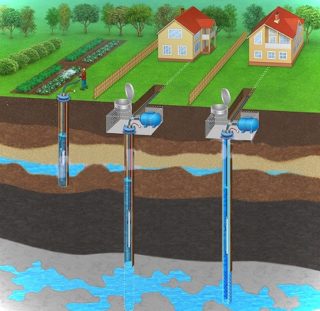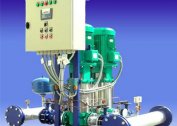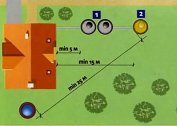When arranging an autonomous source, the location of the well on the site is of great importance. This item has a number of requirements, restrictions on the part of regulatory authorities (regulated by SNiP), as well as general recommendations from professional drillers.
Unsuitable source locations
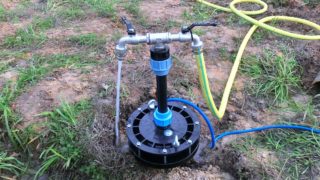
The main condition for drilling a well is the presence of a productive aquifer in a specifically designated location. And yet, under this condition, the installation of the shaft of the shaft is not always possible. Prohibitions on the device of the well:
- Sewer sumps, toilets with cesspools, industrial water discharge points located close to the zone of future drilling.
- The presence of natural sources with contaminated water near a future well.
- Massive plantings with a large root system.
These are recommended parameters to consider when drilling.
Sanitary standards
In SNiP 2.1.4.110-02 the following prohibitions and requirements for the arrangement of wells are regulated:
- For the installation of the mine on an aquifer, a 4x4 m plot should be allotted. Within these limits there should be no outbuildings. Therefore, the question of where it is better to make a well - in a house or on a site - disappears by itself. It must be placed only outside the building.
- It is forbidden to water plants in the garden using chemicals if the plantings are located no further than 20 meters from the future source.
- It is important that cemeteries, industrial enterprises, cattle burial grounds, landfills, etc. are not localized within a radius of 300 meters from the hydraulic structure.
It is not possible to fully comply with the regulations in the private area. But you should get as close to them as possible. This will ensure the correct operation of the source and environmental safety for consumers of the water resource.
Additional source location rules
 Experts advise to adhere to such recommendations when choosing a source location:
Experts advise to adhere to such recommendations when choosing a source location:
- It is better to locate the well at the border with the car entrance to the house (if possible 4-6 meters from the entrance gate). A good place is the lawn.
- If it is impossible to arrange the source in this way, it is better to provide for one removable gate section in the area of the hydraulic structure. If necessary, they simply dismantle it.
- It is strictly forbidden to drill under existing power lines. Especially under high voltage. This is fraught with emergency situations: specialists or later the owners of the site can be shocked.
- Drilling is allowed in a well-dried well. But such technology will cost the owner of the site more expensive.
To determine the most correct place where you can drill a well under water in the area relative to the house, it is better to invite a specialist. He will carry out the necessary geological surveys and outline the optimal location zone of the hydraulic structure.
Methods of location of the well in the area
In total, there are two types of source location on the site - in the basement of the house and outside the building.
The first option is carried out before the construction of the cottage. Here they act rather on the principle of "where I found, I drilled there." Then they begin to plan the building, based on what they have. The advantages of such drilling are as follows:
- the presence of a well in an almost heated basement, which means the exclusion of freezing of the system in winter;
- minimum distances for transporting water, which requires less powerful pumping equipment.
Cons here are more:
- permanent moisture in the basement;
- noise of running pumping equipment;
- difficulties with summing up special equipment if it is necessary to carry out repairs, flushing the source.
Thus, “internally” drilling a well is not the best option. In addition, it is very at odds with sanitary requirements.
As for the location of the hydraulic structure outside the building, there are more advantages:
- Convenience of access of special equipment if necessary to perform maintenance;
- less noise from a running pump;
- the possibility of free watering the garden, the garden without having to pull a long hose from the basement;
- arrangement of a caisson or head in interesting landscape design options.
Of the minuses - the need to install a protective site and warm the upper part of the casing to avoid freezing of the system in winter.
To choose a good place for drilling, it is important to consider the following parameters:
- The depth of the aquifer. Moreover, if several neighboring structures have already been built on it, it is important to remove the new as much as possible so that they do not all feed from the same horizon. Otherwise, the productivity of all wells will fall.
- The presence of plantings in the intended location of the source device. It is better to choose less landscaped (cultivated) zones.
- The relief of the site. A well is not made in its lower part on the slopes, since in the rainy season a large amount of precipitation will flow here and the caisson will be flooded.
It is important to consider that the access to the source should be free for special equipment. Otherwise, in the event of an emergency, the car will damage the landscape design of the area.
What criteria influence the choice of location for a well
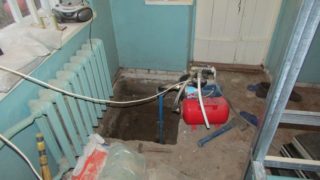
When determining the source location zone, the following points should be taken into account:
- Possibility of free access to the well at any time of the year. If, in order to drill a mine, the master drives the equipment through a neighboring, not yet built up area, this is a temporary phenomenon. Once he will be bought and surely settled. It is unlikely that future neighbors will allow to drive equipment through their yard.
- The need for conservation of the source over time. To do this with a well located in the house (basement) will be unrealistic. A minimally forbidden version of the location of a hydraulic structure in a building is the construction of a greenhouse above it. In extreme cases, it can be quickly disassembled. In addition, the sources, which it was decided to have inside the house, are not repairable. So, they are disposable designs.
Short-term short-sightedness when choosing a place for drilling often turns into big problems during the operation of a ready-made autonomous source.
